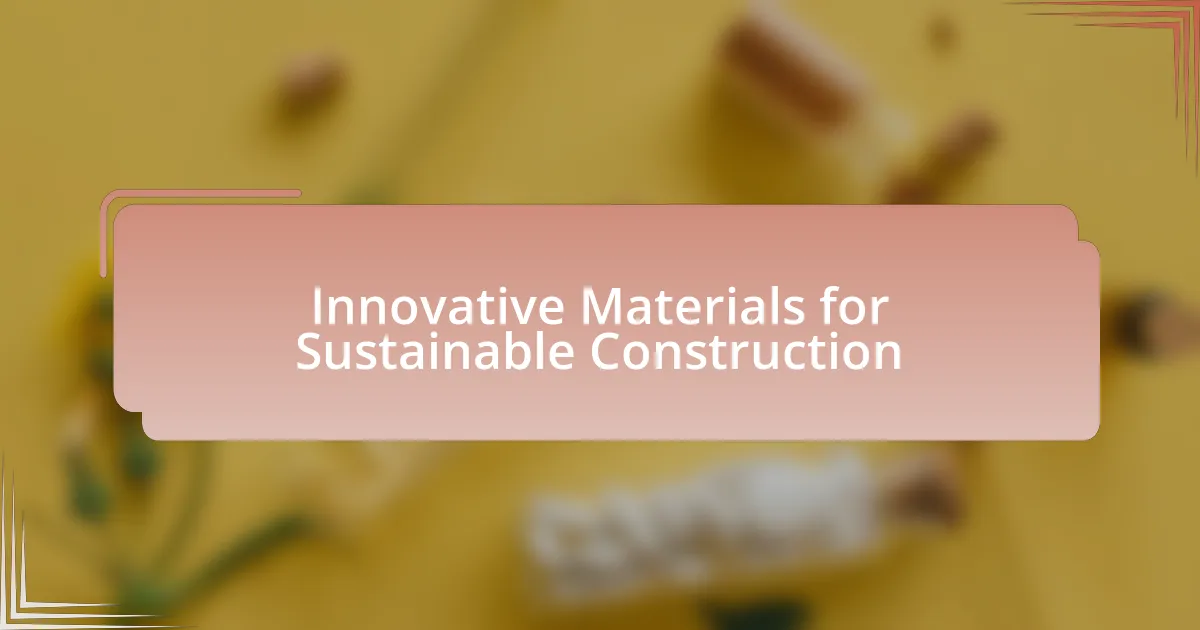Innovative materials for sustainable construction are essential for reducing environmental impact and enhancing energy efficiency in building practices. Key materials include recycled concrete, bamboo, rammed earth, and mycelium-based composites, each contributing to sustainability by minimizing resource consumption and carbon emissions. The article explores how these materials improve durability, reduce lifecycle costs, and promote healthier living environments, while also addressing challenges such as high initial costs and regulatory barriers. Additionally, it highlights the importance of collaboration and education among stakeholders to facilitate the adoption of these innovative solutions in the construction industry.

What are Innovative Materials for Sustainable Construction?
Innovative materials for sustainable construction include recycled concrete, bamboo, rammed earth, and mycelium-based composites. Recycled concrete reduces waste and conserves natural resources by repurposing existing materials, while bamboo offers a fast-growing, renewable alternative to traditional timber. Rammed earth utilizes natural soil to create durable structures with low environmental impact, and mycelium-based composites leverage fungal growth to produce biodegradable building materials. These materials contribute to sustainability by minimizing resource consumption and reducing carbon footprints in construction practices.
How do innovative materials contribute to sustainability in construction?
Innovative materials contribute to sustainability in construction by reducing resource consumption and minimizing environmental impact. For instance, materials such as recycled steel and bamboo require less energy to produce compared to traditional materials like concrete and virgin timber. Additionally, innovations like self-healing concrete can extend the lifespan of structures, reducing the need for repairs and new materials over time. According to a study published in the Journal of Cleaner Production, using recycled materials can decrease carbon emissions by up to 30%, demonstrating the significant environmental benefits of these innovative approaches.
What characteristics define innovative materials in this context?
Innovative materials in the context of sustainable construction are characterized by their environmental sustainability, durability, and adaptability. These materials often utilize recycled or renewable resources, significantly reducing their carbon footprint and promoting resource efficiency. For instance, materials like bamboo and recycled steel exemplify sustainability through their rapid renewability and lower energy consumption during production. Additionally, innovative materials often exhibit enhanced performance characteristics, such as improved thermal insulation and resistance to weathering, which contribute to energy efficiency in buildings. Research indicates that the use of such materials can lead to a reduction in greenhouse gas emissions by up to 30% compared to traditional construction materials, reinforcing their role in sustainable building practices.
How do these materials reduce environmental impact?
Innovative materials for sustainable construction reduce environmental impact by minimizing resource consumption and waste generation. For example, materials like recycled steel and bamboo require less energy to produce compared to traditional materials, resulting in lower carbon emissions. Additionally, the use of sustainable materials can lead to improved energy efficiency in buildings, as seen in structures utilizing insulated concrete forms, which can reduce heating and cooling needs by up to 50%. These practices contribute to a decrease in the overall ecological footprint of construction projects.
Why is the use of innovative materials important in modern construction?
The use of innovative materials is important in modern construction because they enhance sustainability, improve energy efficiency, and reduce environmental impact. Innovative materials, such as recycled composites and bio-based substances, contribute to lower carbon footprints and resource conservation. For instance, the use of recycled steel can reduce energy consumption by up to 75% compared to producing new steel. Additionally, materials like cross-laminated timber not only sequester carbon but also provide structural benefits, making buildings more resilient. These advancements align with global sustainability goals, demonstrating the critical role of innovative materials in addressing climate change and promoting eco-friendly construction practices.
What challenges do traditional materials pose for sustainability?
Traditional materials pose significant challenges for sustainability due to their resource-intensive extraction processes, high carbon emissions during production, and limited recyclability. For instance, concrete production accounts for approximately 8% of global carbon dioxide emissions, primarily from the energy-intensive process of cement manufacturing. Additionally, traditional materials often rely on non-renewable resources, leading to depletion of natural reserves and habitat destruction. Furthermore, many conventional materials, such as plastics and certain metals, are not easily recyclable, contributing to increased waste in landfills and environmental pollution. These factors collectively hinder the transition to more sustainable construction practices.
How can innovative materials address these challenges?
Innovative materials can address challenges in sustainable construction by enhancing energy efficiency, reducing waste, and improving durability. For instance, materials like cross-laminated timber and recycled concrete significantly lower carbon emissions compared to traditional materials, as they utilize renewable resources and minimize landfill contributions. Additionally, bio-based materials, such as mycelium and hempcrete, offer natural insulation properties, which can lead to reduced energy consumption in buildings. Research indicates that using these innovative materials can decrease the overall environmental impact of construction projects by up to 50%, demonstrating their effectiveness in tackling sustainability challenges.
What types of innovative materials are currently being used?
Innovative materials currently being used in sustainable construction include cross-laminated timber (CLT), recycled concrete, and bio-based composites. Cross-laminated timber is gaining popularity due to its strength, lightweight properties, and lower carbon footprint compared to traditional materials like steel and concrete. Recycled concrete utilizes crushed concrete from demolished structures, reducing waste and conserving natural resources. Bio-based composites, made from natural fibers and resins, offer sustainable alternatives to synthetic materials, providing durability while minimizing environmental impact. These materials are supported by research indicating their effectiveness in reducing greenhouse gas emissions and enhancing energy efficiency in buildings.
What are bio-based materials and how are they utilized?
Bio-based materials are materials derived from renewable biological resources, such as plants, animals, and microorganisms. These materials are utilized in various applications, including construction, where they serve as sustainable alternatives to traditional materials like concrete and steel. For instance, bio-based composites made from natural fibers and resins are used in insulation, flooring, and structural components, contributing to reduced carbon footprints and enhanced energy efficiency in buildings. The use of bio-based materials in construction aligns with sustainability goals, as they often require less energy to produce and can be biodegradable or recyclable, thus minimizing environmental impact.
How do recycled materials contribute to sustainable construction?
Recycled materials significantly contribute to sustainable construction by reducing the demand for virgin resources and minimizing waste. Utilizing materials such as reclaimed wood, recycled metal, and repurposed concrete decreases the environmental impact associated with extraction and processing of new materials. For instance, the use of recycled concrete can reduce greenhouse gas emissions by up to 80% compared to traditional concrete production, as reported by the National Ready Mixed Concrete Association. This practice not only conserves natural resources but also promotes a circular economy, where materials are reused and recycled, further enhancing sustainability in the construction industry.
What role do advanced composites play in innovative construction?
Advanced composites play a crucial role in innovative construction by enhancing structural performance while reducing weight and material usage. These materials, such as carbon fiber reinforced polymers and glass fiber composites, offer high strength-to-weight ratios, corrosion resistance, and design flexibility, which are essential for modern architectural and engineering applications. For instance, the use of advanced composites in bridge construction has demonstrated a reduction in overall weight by up to 50% compared to traditional materials, leading to lower transportation costs and easier installation. Additionally, their durability contributes to longer service life and reduced maintenance needs, aligning with sustainability goals in construction.
How are innovative materials developed and tested?
Innovative materials are developed through a systematic process that includes research, design, and testing phases. Researchers and engineers identify specific needs in sustainable construction, such as reducing carbon footprints or enhancing energy efficiency, and then explore new materials or modify existing ones to meet these criteria.
The development phase often involves material synthesis, where components are combined at the molecular level to create new substances with desired properties. For example, bio-based composites may be created from agricultural waste to enhance sustainability.
Testing of these materials is conducted through rigorous evaluation methods, including mechanical testing, durability assessments, and environmental impact analyses. Standards set by organizations like ASTM International guide these tests to ensure reliability and safety. For instance, the performance of a new insulation material might be assessed for thermal resistance and moisture absorption to confirm its effectiveness in real-world applications.
This structured approach ensures that innovative materials not only meet the technical requirements but also contribute positively to sustainable construction practices.
What processes are involved in the research and development of these materials?
The processes involved in the research and development of innovative materials for sustainable construction include material selection, synthesis, characterization, testing, and optimization. Material selection involves identifying sustainable resources and assessing their environmental impact, while synthesis refers to the methods used to create new materials, such as bio-based composites or recycled aggregates. Characterization entails analyzing the physical and chemical properties of these materials to ensure they meet performance standards. Testing evaluates the materials’ durability, strength, and sustainability under various conditions. Finally, optimization focuses on refining the materials and processes to enhance performance and reduce costs, ensuring they are viable for widespread use in construction.
How is performance evaluated for innovative construction materials?
Performance for innovative construction materials is evaluated through a combination of mechanical testing, durability assessments, and sustainability metrics. Mechanical testing includes evaluating properties such as compressive strength, tensile strength, and elasticity, which are essential for determining how materials will perform under load. Durability assessments involve subjecting materials to environmental conditions, such as moisture, temperature fluctuations, and chemical exposure, to gauge their long-term performance. Sustainability metrics assess the environmental impact of materials, including life cycle analysis, carbon footprint, and resource efficiency. These evaluation methods ensure that innovative materials meet industry standards and contribute to sustainable construction practices.

What are the benefits of using innovative materials in construction?
The benefits of using innovative materials in construction include enhanced sustainability, improved energy efficiency, and increased durability. Innovative materials, such as recycled composites and bio-based substances, reduce environmental impact by minimizing waste and lowering carbon emissions during production. For instance, the use of recycled steel can save up to 75% of energy compared to producing new steel. Additionally, materials like aerogels provide superior insulation, leading to reduced energy consumption for heating and cooling. Furthermore, advanced materials often exhibit greater resistance to weathering and wear, extending the lifespan of structures and reducing maintenance costs.
How do these materials enhance energy efficiency?
Innovative materials enhance energy efficiency by improving insulation, reducing energy consumption, and utilizing renewable resources. For instance, materials like aerogels and phase change materials provide superior thermal insulation, which minimizes heat loss in buildings, leading to lower heating and cooling demands. Additionally, materials such as solar panels and green roofs harness renewable energy and reduce reliance on fossil fuels, further contributing to energy efficiency. Studies have shown that buildings using these innovative materials can achieve energy savings of up to 30% compared to traditional construction methods, demonstrating their effectiveness in promoting sustainable energy use.
What specific properties contribute to energy savings?
Specific properties that contribute to energy savings include high thermal insulation, low thermal conductivity, and energy-efficient design. High thermal insulation reduces heat transfer, maintaining indoor temperatures and decreasing heating and cooling demands. Low thermal conductivity materials, such as aerogels or insulated concrete forms, minimize energy loss. Energy-efficient design incorporates passive solar heating, natural ventilation, and daylighting, which collectively reduce reliance on artificial heating, cooling, and lighting systems. These properties are supported by studies indicating that buildings with enhanced insulation can achieve energy savings of up to 30% compared to standard constructions.
How do innovative materials impact building lifecycle costs?
Innovative materials significantly reduce building lifecycle costs by enhancing durability, energy efficiency, and maintenance requirements. For instance, materials like high-performance insulation and energy-efficient windows lower energy consumption, resulting in reduced utility bills over time. Additionally, advanced materials such as self-healing concrete extend the lifespan of structures, minimizing repair and replacement costs. A study by the National Institute of Standards and Technology found that using innovative materials can lead to lifecycle cost savings of up to 20% compared to traditional materials. This demonstrates that the adoption of innovative materials not only improves sustainability but also provides substantial economic benefits throughout the building’s lifecycle.
What are the social benefits of using sustainable materials?
The social benefits of using sustainable materials include improved community health, enhanced quality of life, and increased social equity. Sustainable materials often reduce harmful emissions and pollutants, leading to healthier living environments. For instance, using low-VOC (volatile organic compounds) materials in construction can significantly decrease indoor air pollution, which is linked to respiratory issues and other health problems. Additionally, sustainable materials can foster local economies by supporting local suppliers and creating jobs in green industries. A study by the World Green Building Council found that green buildings can enhance occupant well-being and productivity, demonstrating the positive impact of sustainable materials on social aspects.
How do innovative materials improve occupant health and comfort?
Innovative materials improve occupant health and comfort by enhancing indoor air quality, regulating temperature, and providing better acoustics. For instance, materials like low-VOC paints and formaldehyde-free insulation reduce harmful emissions, leading to healthier indoor environments. Additionally, phase change materials can help maintain stable temperatures, reducing the need for excessive heating or cooling, which contributes to comfort. Furthermore, sound-absorbing materials can minimize noise pollution, creating a more peaceful living space. Studies have shown that improved indoor air quality and thermal comfort can lead to increased productivity and well-being among occupants.
What role do these materials play in community resilience?
Innovative materials for sustainable construction enhance community resilience by providing durable, adaptable, and environmentally friendly solutions to building challenges. These materials, such as recycled plastics, bamboo, and advanced composites, contribute to reducing the carbon footprint of construction, which is crucial in mitigating climate change impacts. For instance, using recycled materials can lower resource consumption and waste generation, while bamboo’s rapid growth and strength offer a sustainable alternative to traditional timber. Studies indicate that communities utilizing such materials experience improved structural integrity and reduced vulnerability to natural disasters, thereby fostering long-term resilience.
What are the economic implications of adopting innovative materials?
Adopting innovative materials in construction leads to significant economic implications, including cost savings, increased efficiency, and enhanced market competitiveness. For instance, materials such as recycled plastics and advanced composites can reduce raw material costs and lower waste disposal expenses, contributing to overall project savings. Additionally, innovative materials often improve energy efficiency in buildings, resulting in lower utility bills and long-term operational savings. A study by the National Institute of Standards and Technology found that using advanced materials can reduce construction time by up to 30%, further decreasing labor costs and accelerating return on investment. These factors collectively enhance the economic viability of construction projects, making them more attractive to investors and stakeholders.
How can innovative materials lead to cost savings in construction projects?
Innovative materials can lead to cost savings in construction projects by reducing labor costs, minimizing waste, and enhancing energy efficiency. For instance, materials like precast concrete and modular components streamline the construction process, allowing for faster assembly and less on-site labor. Additionally, advanced materials such as recycled plastics and high-performance insulation can lower energy consumption during the building’s lifecycle, resulting in reduced utility bills. According to a study by the National Institute of Standards and Technology, using innovative materials can decrease construction costs by up to 20% while improving overall project efficiency.
What are the potential market opportunities for businesses using these materials?
Businesses using innovative materials for sustainable construction can tap into significant market opportunities, including the growing demand for eco-friendly building solutions. The global green building materials market is projected to reach approximately $364 billion by 2022, driven by increasing environmental regulations and consumer preferences for sustainable practices. Additionally, companies can benefit from government incentives and funding aimed at promoting sustainable construction, which can enhance profitability and market share. The rise in urbanization and the need for energy-efficient buildings further create avenues for businesses to innovate and differentiate their offerings in a competitive landscape.

What challenges are associated with the adoption of innovative materials?
The challenges associated with the adoption of innovative materials include high initial costs, lack of standardized testing, and limited knowledge among stakeholders. High initial costs can deter investment, as innovative materials often require significant upfront capital for research, development, and implementation. The absence of standardized testing protocols complicates the evaluation of these materials’ performance and safety, leading to uncertainty in their reliability. Furthermore, limited knowledge among architects, engineers, and builders about the benefits and applications of innovative materials can hinder their widespread acceptance and integration into construction practices. These factors collectively impede the transition to more sustainable construction methods that utilize innovative materials.
What barriers do construction professionals face when implementing these materials?
Construction professionals face several barriers when implementing innovative materials for sustainable construction, including high initial costs, lack of familiarity, and regulatory challenges. High initial costs can deter investment, as many sustainable materials require significant upfront expenditure despite potential long-term savings. Lack of familiarity with new materials can lead to resistance among professionals who are accustomed to traditional methods, resulting in a steep learning curve and potential project delays. Regulatory challenges arise from building codes and standards that may not yet accommodate innovative materials, complicating compliance and approval processes. These barriers collectively hinder the widespread adoption of sustainable construction practices.
How does the lack of awareness affect the adoption of innovative materials?
The lack of awareness significantly hinders the adoption of innovative materials in sustainable construction. When stakeholders, including builders, architects, and consumers, are unaware of the benefits and availability of these materials, they are less likely to incorporate them into their projects. For instance, a study by the National Institute of Standards and Technology found that only 30% of construction professionals were familiar with advanced materials like self-healing concrete or recycled plastic composites. This lack of knowledge leads to missed opportunities for improved sustainability, cost savings, and enhanced performance in construction practices.
What are the regulatory challenges related to innovative materials?
Regulatory challenges related to innovative materials include the lack of established standards, lengthy approval processes, and insufficient testing protocols. These challenges arise because innovative materials often do not fit into existing regulatory frameworks, which are typically designed for traditional materials. For instance, the European Union’s Construction Products Regulation requires that new materials demonstrate performance and safety, but many innovative materials lack the necessary data to meet these requirements. Additionally, the slow pace of regulatory adaptation can hinder the timely introduction of sustainable innovations into the market, as seen in the case of biobased materials that face scrutiny over their environmental impact despite their potential benefits.
How can these challenges be overcome?
To overcome challenges in innovative materials for sustainable construction, collaboration among stakeholders is essential. Engaging architects, engineers, manufacturers, and policymakers fosters the development of materials that meet sustainability criteria while addressing performance and cost concerns. For instance, the use of recycled materials can reduce environmental impact, as demonstrated by a study from the University of Cambridge, which found that incorporating recycled aggregates in concrete can lower carbon emissions by up to 30%. Additionally, investing in research and development can lead to breakthroughs in material properties, enhancing durability and reducing lifecycle costs. This approach not only addresses immediate challenges but also promotes long-term sustainability in the construction industry.
What strategies can be employed to educate stakeholders about innovative materials?
To educate stakeholders about innovative materials, targeted workshops and seminars can be employed as effective strategies. These educational sessions can provide hands-on demonstrations and case studies showcasing the benefits and applications of innovative materials in sustainable construction. Research indicates that interactive learning environments significantly enhance knowledge retention, making workshops particularly effective (National Training Laboratory, 2000). Additionally, creating informative digital content, such as webinars and online courses, can reach a broader audience and facilitate ongoing education. Engaging stakeholders through newsletters and social media platforms can also disseminate information about advancements in innovative materials, fostering a community of informed participants.
How can collaboration between industries facilitate the adoption of these materials?
Collaboration between industries can facilitate the adoption of innovative materials for sustainable construction by enabling knowledge sharing, resource pooling, and standardization of practices. When construction firms partner with material manufacturers, they can exchange insights on material performance, leading to improved product development and tailored solutions that meet specific project needs. For instance, joint research initiatives can result in the creation of more efficient and environmentally friendly materials, as seen in the collaboration between the construction and chemical industries, which has led to the development of bio-based composites. Furthermore, collaborative efforts can establish industry standards that promote the use of sustainable materials, making it easier for companies to adopt these innovations. This approach has been validated by the success of initiatives like the Carbon Leadership Forum, which brings together various stakeholders to advance sustainable building practices through shared goals and resources.
What are best practices for integrating innovative materials into construction projects?
Best practices for integrating innovative materials into construction projects include thorough research and evaluation of material properties, collaboration with suppliers and manufacturers, and adherence to sustainability standards. Conducting life cycle assessments helps determine the environmental impact of materials, ensuring that choices align with sustainability goals. Engaging in early-stage design discussions allows for the seamless incorporation of innovative materials, while continuous training for project teams on new technologies and materials fosters effective implementation. Additionally, utilizing building information modeling (BIM) can enhance visualization and integration processes, leading to improved project outcomes. These practices are supported by industry reports indicating that projects employing innovative materials can reduce waste and energy consumption significantly, contributing to overall sustainability in construction.
How can project managers effectively select and implement these materials?
Project managers can effectively select and implement innovative materials for sustainable construction by conducting thorough research on material properties, sustainability certifications, and cost-effectiveness. They should evaluate materials based on their environmental impact, durability, and compliance with industry standards, such as LEED or BREEAM certifications. Additionally, engaging with suppliers and manufacturers to understand the latest advancements and availability of materials can enhance decision-making. A study by the National Institute of Standards and Technology indicates that using sustainable materials can reduce construction waste by up to 30%, reinforcing the importance of informed selection and implementation strategies.
What considerations should be made for long-term sustainability in material choice?
Long-term sustainability in material choice requires evaluating the environmental impact, resource availability, and lifecycle of materials. Selecting materials with low embodied energy, such as recycled or renewable resources, minimizes carbon emissions during production. Additionally, assessing the durability and maintenance needs of materials ensures longevity, reducing the frequency of replacement and waste generation. For instance, using bamboo, which grows rapidly and absorbs carbon dioxide, exemplifies a sustainable choice. Furthermore, considering local sourcing reduces transportation emissions and supports regional economies. Research indicates that sustainable material choices can lead to a 30% reduction in greenhouse gas emissions in construction projects, highlighting the importance of these considerations.


